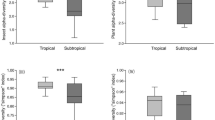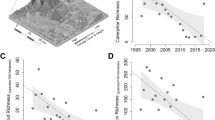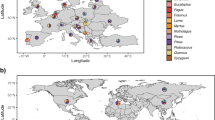Abstract
Two decades of research1,2,3,4 have not established whether tropical insect herbivores are dominated by specialists or generalists. This impedes our understanding of species coexistence in diverse rainforest communities. Host specificity and species richness of tropical insects are also key parameters in mapping global patterns of biodiversity1,4,5. Here we analyse data for over 900 herbivorous species feeding on 51 plant species in New Guinea and show that most herbivorous species feed on several closely related plant species. Because species-rich genera are dominant in tropical floras, monophagous herbivores are probably rare in tropical forests. Furthermore, even between phylogenetically distant hosts, herbivore communities typically shared a third of their species. These results do not support the classical view that the coexistence of herbivorous species in the tropics is a consequence of finely divided plant resources; non-equilibrium models of tropical diversity6 should instead be considered. Low host specificity of tropical herbivores reduces global estimates of arthropod diversity from 31 million (ref. 1) to 4–6 million species. This finding agrees with estimates based on taxonomic collections, reconciling an order of magnitude discrepancy between extrapolations of global diversity based on ecological samples of tropical communities with those based on sampling regional faunas7,8.
This is a preview of subscription content, access via your institution
Access options
Subscribe to this journal
Receive 51 print issues and online access
$199.00 per year
only $3.90 per issue
Buy this article
- Purchase on Springer Link
- Instant access to full article PDF
Prices may be subject to local taxes which are calculated during checkout



Similar content being viewed by others
References
Erwin, T. L. Tropical forests: their richness in Coleoptera and other species. Coleopterist's Bull. 36, 74–75 (1982)
Basset, Y. Host specificity of arboreal and free-living insect herbivores in rain forests. Biol. J. Linn. Soc. 47, 115–133 (1992)
Barone, J. A. Host-specificity of folivorous insects in a moist tropical forest. J. Anim. Ecol. 67, 400–409 (1998)
Ødegaard, F. How many species of arthropods? Erwin's estimate revised. Biol. J. Linn. Soc. 71, 583–597 (2000)
Stork, N. E. How many species are there? Biodivers. Conserv. 2, 215–232 (1993)
Hubbell, S. P. The Unified Neutral Theory of Biodiversity and Biogeography (Princeton Univ. Press, Princeton, 2001)
May, R. M. in Nature and Human Society: The Quest for a Sustainable World (eds Raven, P. H. & Williams, T.) 30–45 (National Academy Press, Washington DC, 2000)
Nielsen, E. S. & Mound, L. A. in Nature and Human Society: The Quest for a Sustainable World (eds Raven, P. H. & Williams, T.) 312–322 (National Academy Press, Washington DC, 2000)
Thomas, C. D. Herbivore diets, herbivore colonization, and the escape hypothesis. Ecology 71, 610–615 (1990)
Marquis, R. J. in Plant–Animal Interactions: Evolutionary Ecology in Tropical and Temperate Regions (eds Price, P. W., Lewinsohn, T. M., Fernandes, G. W. & Benson, W. W.) 179–208 (Wiley, London, (1991)
Mabberley, D. J. The Plant Book (Cambridge Univ. Press, Cambridge, 1987)
Burger, W. & Taylor, C. M. Flora Costaricensis: Family #202 Rubiaceae. Fieldiana Botany, N.S. 33, 1–333 (1993)
Höft, R. Plants of New Guinea and the Solomon Islands. Dictionary of the Genera and Families of Flowering Plants and Ferns (Wau Ecology Institute, Wau, 1992)
Gentry, A. H. (ed.) Four Neotropical Forests (Yale Univ. Press, New Haven, 1990)
Jolivet, P. & Hawkeswood, T. J. Host-Plants of Chrysomelidae of the World (Backhuys, Leiden, 1995)
Janzen, D. H. Ecological characterization of a Costa Rican dry forest caterpillar fauna. Biotropica 20, 120–135 (1988)
May, R. M. How many species? Phil. Trans. R. Soc. Lond. B 330, 293–304 (1990)
Basset, Y., Samuelson, G. A., Allison, A. & Miller, S. E. How many species of host-specific insects feed on a species of tropical tree? Biol. J. Linn. Soc. 59, 201–216 (1996)
Sekhran, N. & Miller, S. E. (eds) Papua New Guinea Country Study on Biological Diversity (Papua New Guinea Dept of Environment & Conservation, Waigani, Papua New Guinea, 1996)
Parsons, M. The Butterflies of Papua New Guinea (Academic, London, 1999)
Miller, S. E., Novotny, V. & Basset, Y. in Foundations of Tropical Biology: Key Papers and Commentaries (eds Chazdon, R. L. & Whitmore, T. C.) (Univ. Chicago Press, Chicago, in the press).
Leps, J., Novotny, V. & Basset, Y. Habitat and successional optimum of plants and the composition of their leaf-chewing herbivores in Papua New Guinea. J. Ecol. 89, 186–199 (2001)
Basset, Y., Novotny, V., Miller, S. E. & Pyle, R. Quantifying biodiversity: experience with parataxonomists and digital photography in Papua New Guinea and Guyana. BioScience 50, 899–908 (2000)
Angiosperm Phylogeny Group An ordinal classification for the families of flowering plants. Ann. Missouri Bot. Gard. 85, 531–553 (1998)
Weiblen, G. D. Phylogenetic relationships of functionally dioecious Ficus (Moraceae) based on ribosomal DNA sequences and morphology. Am. J. Bot. 87, 1342–1357 (2000)
Backlund, M., Oxelman, B. & Bremer, B. Phylogenetic relationships within the Gentianales based on ndhF and rbcL sequences, with particular reference to the Loganiaceae. Am. J. Bot. 87, 1029–1043 (2000)
Soltis, D. E. et al. Angiosperm phylogeny inferred from 18S rDNA, rbcL, and atpB sequences. Bot. J. Linn. Soc. 133, 381–461 (2000)
Qiu, Y.-L. et al. The earliest angiosperms. Evidence from mitochondrial, plastid and nuclear genomes. Nature 402, 404–407 (1999)
Bremer, B. et al. More characters or more taxa for a robust phylogeny—case study from the coffee family (Rubiaceae). Syst. Biol. 48, 413–435 (1999)
Powell, J. A., Mitter, C. & Farrell, B. in Lepidoptera, Moths and Butterflies Vol. 1: Evolution, Systematics, and Biogeography (ed. Kristensen, N. P.) 403–422 (Walter de Gruyter, Berlin, 1998)
Acknowledgements
We thank parataxonomists J. Auga, W. Boen, C. Dal, S. Hiuk, B. Isua, M. Kasbal, R. Kutil, M. Manumbor and K. Molem and also K. Darrow and N. Heidari for assistance; many insect collectors and taxonomists are acknowledged elsewhere. N. Stork, T. Lewinsohn, J. Zrzavy, J. Leps and A. Stewart commented on the manuscript. This work was supported by the National Science Foundation (USA), Christensen Fund (USA), Grant Agency of the Czech Republic, Czech Academy of Sciences, the Swedish Natural Science Research Council, Czech Ministry of Education, Otto Kinne Foundation, Darwin Initiative (UK), International Centre of Insect Physiology and Ecology (ICIPE) and Bishop Museum.
Author information
Authors and Affiliations
Corresponding author
Ethics declarations
Competing interests
The authors declare that they have no competing financial interests
Rights and permissions
About this article
Cite this article
Novotny, V., Basset, Y., Miller, S. et al. Low host specificity of herbivorous insects in a tropical forest. Nature 416, 841–844 (2002). https://doi.org/10.1038/416841a
Received:
Accepted:
Issue Date:
DOI: https://doi.org/10.1038/416841a
This article is cited by
-
34-kDa salivary protein enhances duck Tembusu virus infectivity in the salivary glands of Aedes albopictus by modulating the innate immune response
Scientific Reports (2023)
-
Elevational changes in canopy Collembola community composition are primarily driven by species turnover on Changbai Mountain, northeastern China
Biodiversity and Conservation (2023)
-
Effects of post-mining forest restoration and alternative land uses on ground-dwelling arthropods in Ghana
Community Ecology (2023)
-
Composition and phylogenetic structure of Pampean grasslands under distinct land use and presence of alien species
Community Ecology (2023)
-
Changes in herbivory patterns and insect herbivore assemblages associated to canopy of Quercus laurina: importance of oak species diversity and foliar chemical defense
Trees (2023)
Comments
By submitting a comment you agree to abide by our Terms and Community Guidelines. If you find something abusive or that does not comply with our terms or guidelines please flag it as inappropriate.



